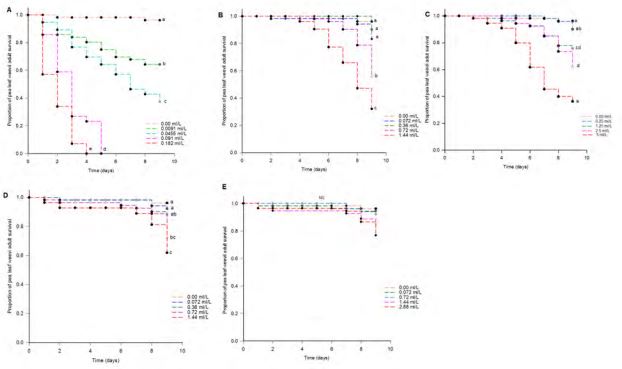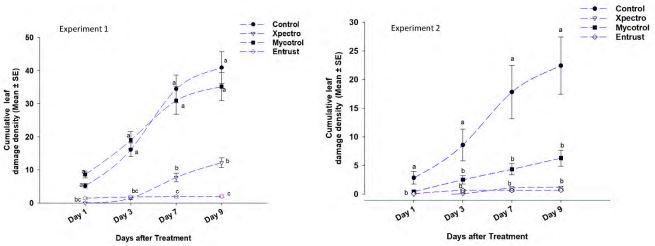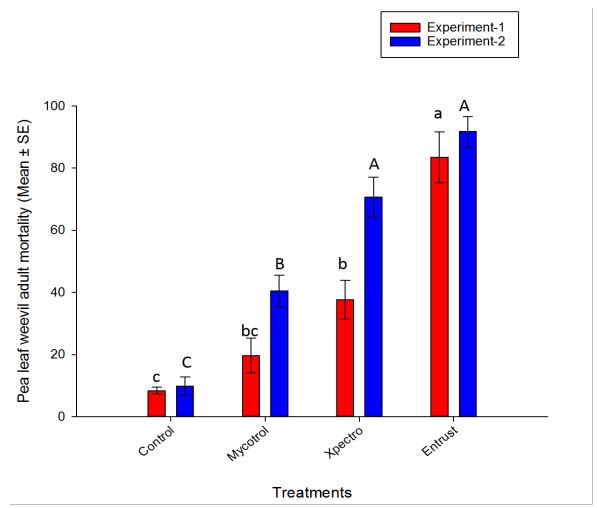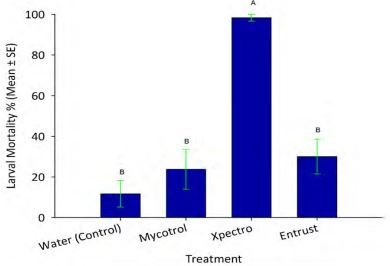Laboratory bioassays and cage trials for the evaluation of the effect of biopesticides on field-collected pea leaf weevil adults and the impact on non-target organisms
Principal Investigator: Gadi V.P. Reddy
Project Personnel: Govinda Shrestha, Ramadevi L. Gadi and Debra Miller
Western Triangle Agricultural Research Center,
Montana State University, 9546 Old Shelby Rd.,
P.O. Box 656 Conrad, MT 59425, USA
Aim of the Study
The aim of the study was: 1) to evaluate commercially available bio-pesticides such as Entrust WP® (Spinosad, Saccharopolyspora spinosa), PyGanic EC® (Pyrethrin), Mycotrol ESO® (Beauveria bassiana GHA), Xpulse OD® (B. bassiana GHA + Cold pressed Neem extract) and Xpectro OD® (B. bassiana GHA + Pyrethrin) against pea leaf weevil adults Sitona lineatus under lab and cage conditions and 2) to test the toxicity of bio-pesticides on the two natural enemies (lacewing and ladybeetle).
Materials and methods
Plants
Green pea, Pisum sativum L. cv. ‘Banner’, was used as a plant material source for the cage experiments. Seeds were sown on tapered square pots (13 ×13 ×13.5 cm) at a rate of six seeds per pot from 2nd - 4th weeks of May, 2018. Each pot contained 1.62 kg of prepared soil mixture, with 1:1:2 proportions sand, potting mix and clay loam soil, respectively. Pots were placed inside insect cages (68 ×75 × 82 cm) and plants were maintained in outdoor natural environmental condition at the Western Triangle Agricultural Research Center (WTARC) of Montana State University, USA, until plants used for experiments.
Insect
Pea leaf weevil
Spring population of S. lineatus adults collected in pea and alfalfa fields, were used for all the experiments. Adults were collected either using the pitfall traps baited with lures 4-methyl-3, 5- heptanedione (ChemTica Internacional, Costa Rica) in pea fields (Reddy et al., 2018) or the sweep net sampling in 2016 and 2018, Pondera County, Montana, USA. Collected adults were placed inside deli cups (diameter = 12 cm and height = 8 cm) (50 per cup), reared with alfalfa foliage (5- 6 stems) and maintained in a climate cabinet at 12 oC for 2-3 days, until sufficient adults were obtained to perform the experiments.
Beneficial insects
One- to two-day-old first instar green lacewing, Chrysoperla carnea Stephens (Neuroptera: Chrysopidae) and two-spotted ladybeetle, Adalia bipunctata L. (Coleoptera: Coccinellidae) larvae were purchased from Biobest Canada Ltd. (www.biobestgroup.com ). The flour moth, Ephestia kuehniella Zeller (Lepidoptera: Pyralidae) eggs were supplied from Beneficial Insectary, CA (www.insectary.com) and used as a source of food materials for rearing of beneficial insect species.
Chemical source and rate
Five bio-pesticide products of commercial formulations were used for the study (Table 1). Mycotrol ESO® (Beauveria bassiana GHA), Xpectro OD® (Beauveria bassiana GHA + pyrethrins) and Xpulse OD® (Beauveria bassiana GHA + Azadirachtin) were obtained from Lam International (Butte, MT), Entrust WP® (Spinosad 80%) from Dow Agro Sciences (Indianapolis, IN) and, PyGanic EC® 1.4 (Pyrethrin) from McLaughlin Gormley King (Minneapolis, MN).
Table 1. Materials and application rates of bio-pesticides used for the laboratory bioassays against Sitona lineatus adults.
|
Treatment |
Chemical name |
Trade name |
Concentration (ml/L) |
|
T1 |
Untreated Control |
|
|
|
T2 |
Spinosad (Saccharopolyspora spinosa) |
Entrust WP® |
0.0091, 0.0455, 0.091 and 0.182 |
|
T3 |
Beauveria bassiana |
Mycotrol ESO® |
0.072, 0.36, 0.72 and 1.44 |
|
T4 |
B. bassiana GHA + Pyrethrin |
Xpectro OD® |
0.25, 1.25, 2.5 and 5 |
|
T5 |
B. bassiana GHA + Cold pressed neem
extract |
Xpulse OD® |
0.072, 0.36, 0.72 and 1.44 |
|
T6 |
Pyrethrin |
PyGanic EC® |
0.072, 0.72, 1.44 and 2.88 |
Laboratory experiments
Pea leaf weevil adult mortality
The bioassay experiment was performed to quantify the susceptibility of S. lineatus adults to four concentrations of each product material (0.1, 0.5, 1.0 and 2.0 fold lowest label rate) and a control (water). Stock solutions were first prepared for each product by dissolving the product materials in tap water and the lower concentrations were prepared via. serial dilutions with tap water (Table 1). However, prior to executing experiments, the two spraying methods-immersion and topical (bottle and perfume sprayer) were assessed to find out the most appropriate one for experiments. The perfume sprayer method was found suitable for bioassay experiment as other spraying techniques caused the higher adults mortality (~ 80%) both in treatments and control groups after 48 h.
Similar sized pea leaf weevil adults (length = 5-5.5 mm) were placed in groups of seven adults in a Petri dish lined with a filter paper (diameter = 9 cm). Placement of the adults was accomplished with the help of a fine camel paint brush. The Petri dishes were then maintained in a cold climate cabinet (5 oC) for 1 h to minimize adults’ movement. Adult individuals group were placed in the
center of Petri dish and then topically treated with 1 ml of tested bio-pesticide product suspension. Controls were treated with 1.0 ml of tap water. After the spray applications, a fresh alfalfa stem about 5 cm long with 9-12 leaves, was placed close to the treated adult individuals inside a Petri dish as a source of feeding materials. Feeding materials were replaced within 2-3 day intervals. Dishes were incubated in a climate cabinet at 22 ± 1 oC, 16:8 h L:D and 75% RH. The number of replicates (one replicate equals one Petri dish) per treatment were 5 and 3, respectively, in the first and second experimental run (providing a total of 8 replicates per treatment).
Starting one day after the treatment, adult mortality was checked daily for 9 days. S. lineatus adults have a specific characteristic such as acting like dead weevils “dead play” even with minimum disturbance (Jackson and Macdougall, 1920). Therefore, by gentle prodding with a camel paint brush, the adult mortality was determined in Petri dish. Any adults that lacked movement were considered to be dead. Dead weevils, mainly from insect pathogenic fungi or mixture with other product, were further placed on moist filter paper lined in a Petri dish to check for sporulation.
Beneficial insects: Laboratory bioassay
The bioassay experiment was performed to determine the toxicities of Mycotrol (1.44 ml/L), Xpectro (5 ml/L) and Entrust (0.182 ml/L) bio-pesticide products on the first instar larvae of lacewing and two-spotted ladybeetles. Similar sized larvae of each beneficial insect species were placed in groups of 10 individuals in a Petri dish (diameter = 9 cm). Placement of the larvae was accomplished with the help of a fine camel paint brush, and placed in the center of Petri dish. Each bio-pesticide product was sprayed topically to test individuals using a 750 ml hand-held sprayer, with a spray volume of 1 ml per Petri dish. Controls were treated with 1.0 ml of tap water. Immediately after spraying (about 5 sec), the bio-pesticide exposed larvae were transferred individually to plastic deli cups with an excess of E. kuehniella eggs. Dishes were incubated in a climate cabinet at 22 ± 1 ºC, 16:8 h L: D and 75% RH. Beginning from day one after the treatment, larval mortality was checked at one-two days interval for seven days. Dead larvae, particularly from insect pathogenic fungi (Mycotrol) or mixture with other product (Xpectro), were removed and placed on moist filter paper in a Petri dish to check for sporulation. The bioassay experiment was performed 2-3 times within a period of two months (October-December, 2017). The number of replicates (one replicate = one Petri dish) per treatment was three in each experimental run (providing a total of six to nine replicates per treatment).
Cage experiments
Cage experiments were performed to determine the impact of bio-pesticide products on foliage damage and pea leaf weevil adult mortality. Pea plants established outdoors were transported to a lab, placed in small cages with three pots per cage and contained four plants in each pot. Each potted plant was marked individually to know the order of plant monitoring. Caged plants were inoculated with 8-9 adult individuals per pot (totaling 25 weevil individuals in three pots of each cage). At the time of biopesticide application, the pea plants were 24 days old and had three pairs of unfolded leaves. Plants inoculated with adults were transported to spraying room and were immediately sprayed with a 750 ml hand-held sprayer at concentrations of 1.44 ml/L, 0.182 ml/L and 5 ml/L for Mycotrol, Entrust and Xpectro, respectively. Twelve plants in each cage were sprayed with 10 mL of each product concentration. Control plants were treated with tap water. Adult mortality and leaf notch damage caused by adults were assessed 1, 3, 7 and 9 days post
treatment. In addition, plants were always checked in counter clock fashion for maintaining consistency in repeated observations for leaf notch damage. The experiment was performed twice within a month. The number of replicates (one replicate = one cage) per treatment was four in each experimental run (providing a total of eight replicates per treatment).
Statistical analysis
Lab bioassay data on cumulative mortality were corrected for the mortality in the controls (Abbott, 1925). Mortality data were angular transformed. Two way analysis of variance (ANOVA) was performed in order to determine the overall influence of biopesticide product and concentration level on mortality. One way analysis of variance (ANOVA) was carried out to determine 1) the effect on mortality across biopesticide product and 2) the effect on mortality across concentration level. For cage experiments, one way analysis of variance (ANOVA) was carried the impact of bio-pesticide products on foliage damage and adult mortality. Similar procedure was used to examine the toxicities of Mycotrol, Xpectro and Entrust bio-pesticide products on the beneficial insects’ larvae. Tukey’s contrast pairwise multiple comparison was used to compare significant differences in means.
Log-rank Kaplan–Meier survival analyses were performed to compare survival in treatments for each biopesticide product. Pairwise multi comparison procedures were conducted to compare survival among the five treatments, using Holm-Sidak method. Survival analyses were conducted with Sigma Plot 12.3.
Results
Laboratory experiments
Pea leaf weevil adult mortality
Overall, this bioassay study revealed significant main effects on pea leaf weevil adult mortality for both concentration level (F = 119.52; df = 4, 140; P < 0.0001) and biopesticide product type (F = 157.01; df = 4, 140; P <0.0001) with a significant interaction effect (F = 6.13; df = 12, 140; P <0.0001).
Across the biopesticide product type, significant differences in adult mortality occurred when adults were treated with either high (F = 69.98; df = 4, 35; P < 0.0001), medium (F = 72.65; df = 4, 35; P < 0.0001), low (F = 22.98; df = 4, 35; P < 0.0001) or very low (F = 15.38; df = 4, 35; P <0.0001) label rates of each biopesticide product. Among five products, Entrust was found to be highly effective, Mycotrol and Xpectro as moderately effective and the Xpulse and Pyganic as less effective products, with evidence of significant differences between products (Table 2).
Within each biopesticide product treated with high, medium, low or very low label rate of biopesticide product, there was a significant difference in mortality inflicted by biopesticide product: Entrust (F = 204.1; df = 3, 28; P < 0.0001), Xpectro (F = 21.99; df = 3, 28; P < 0.0001),
Mycotrol (F = 28.67; df = 3, 28; P < 0.0001), Xpulse (F = 11.48; df = 3, 28; P < 0.0001)and Pyganic (F = 4.58; df = 3, 28; P < 0.01). The mortality caused by the biopesticide was generally dose-dependent with the highest mortality recorded with highest concentration, except that no significant difference was observed in the mortality of adults treated with high or medium concentration of Entrust (Table 2). Mean levels of mortality in biopesticide treated groups ranged from 36 to 100 % for Entrust, 6 to 60 % for Xpectro, 6 to 62 % for Mycotrol, 5 to 32 for Xpulse and 3 to 17 % for Pyganic (low dose to high label rate, respectively; Table 2). The average control mortality (± SE) was 4.32 ± 2.40, 9 days post-inoculation.
Table 2. Effect of biopesticide products on total mortality of pea leaf weevil adults. Mean percentage of corrected mortality (± SE) 9 days post inoculation.
|
Concentration |
||||
|
Treatments |
2 X |
1 X |
0.5 X |
0.1 X |
|
Entrust |
100.00 ± 0.00Aa |
100.00 ± 0.00Aab |
62.50 ± 4.91Ac |
36.25 ± 3.75Ad |
|
Xpectro |
60.62 ± 6.30Ba |
32.50 ± 6.34Bb |
19.37 ± 3.95Bbc |
6.25 ± 1.82Bd |
|
Mycotrol |
62.50 ± 4.91Ba |
38.12 ± 5.97Bb |
11.25 ± 3.37Bcd |
6.24 ± 1.83Bd |
|
Xpulse |
32.50 ± 5.67Ca |
21.25 ± 3.75BCab |
8.12 ± 2.98Bcd |
4.99 ± 1.89Bd |
|
Pyganic |
17.49 ± 4.00Ca |
11.25 ± 3.37Cab |
5.62 ± 3.19Bb |
3.74 ± 1.83Bb |
Mean values within columns bearing the same upper case letter and within rows bearing the same lower case letters are not significantly different (Tukey test, P > 0.05). Data pooled over the two experimental runs. The total numbers of replicates were eight per treatment.
Survival curve
Pea leaf weevil adults exposed with different concentrations of biopesticide products were significantly affected in terms of adult survival curve over the nine days post inoculation period: Entrust (log-rank, df = 4; x2= 332.94; P<0.001), Xpectro (log-rank, df = 4; x2= 75.68; P<0.001), Mycotrol (log-rank, df = 4; x2= 91.59; P<0.001) and Xpulse (log-rank, df = 4; x2= 29.14; P<0.001) (Figure 1). Expect, the Pyganic biopesticide product had no significant effect (log-rank, df = 4; x2= 7.20; P>0.05) on adult survival curve (Fig. 1). In Entrust treatment, across the concentration levels, significantly lower survival curve of pea leaf weevil adults were recorded when adults were exposed with high, medium and low concentrations compared with control treated groups (Figure 1).There were also significant differences in the survival curve of adults exposed to high, medium and low concentrations of Entrust (Figure 1). For both Xpectro and Mycotrol treatments, adults exposed with high and medium concentrations had only significantly lower survival curve and merely with high concentration of Xpulse, when compared with control treatment (Figure 1).
Figure 1. Survival curves for pea leaf weevil adults subjected to increasing sublethal concentrations of Entrust (A), Xpectro (B), Mycotrol (C), Xpulse (D) and Pyganic (E). Survival curves of different colors differed by Holm-Sidakis test (P > 0.05).
Cage experiments
Leaf damage assessment
In overall, this study demonstrated main significant effect on pea leaf damages for both treatment and sampling timing, regardless of experiment: Exp. 1 (treatment: F = 96.27; df = 3, 224; P = 0.0001; sampling time: F = 50.16; df = 3, 224; P = 0.0001) and Exp 2. (treatment: F = 45.66; df =3, 152; P = 0.0001; sampling time: F = 11.80; df = 3, 152; P = 0.0001) (Figure 2). There was also significant interaction between treatment and sampling time (Exp.1: F = 8.75; df = 9, 224; P = 0.0001 and Exp. 2: F = 5.14; df = 9, 152; P = 0.0001) (Figure 2). In both experiment, significant difference in pea leaf weevil leaf damage occurred in all post treatment across the treatment levels: 1 day (Exp.1: F = 37.48; df = 3, 56; P = 0.0001 and Exp. 2: F = 7.36; df =38; P = 0.0001), 3 days (Exp.1: F = 31.43; df = 3, 56; P = 0.0001 and Exp. 2: F = 9.53; df = 3, 38; P = 0.0001), 7 days (Exp.1: F = 29.34; df = 3, 56; P = 0.0001 and Exp. 2: F = 13.71; df = 3, 38; P = 0.0001) and 9 days (Exp.1: F = 31.25; df = 3, 56; P = 0.0001 and Exp. 2: F = 18.7; df = 3, 38; P = 0.0001) (Figure 2).
Figure 2. Impact of bio-pesticide products on pea foliage damage measured via leaf notch numbers caused by pea leaf weevil adults. Mean values within line graph at each sampling time bearing the same lower-case letters are not significantly different (Tukey test, P > 0.05).
In experiment 1, Entrust and Xpectro were significantly effective in reducing pea leaf weevil adult damage compared to the control and the Mycotrol treatment throughout sampling times, keeping the numbers of notch below 12 (Figure 2). Adults generally caused similar level of leaf damage when compared with untreated leaves (water) and leaves treated with Mycotrol (Figure 2). Similarly, in the experiment 2, significantly less leaf damage was recorded not only for the treatments with Entrust and Xpectro but also with Mycotrol compared to the untreated leaf (water) (Figure 2).
Pea leaf weevil adult mortality
This cage study depicted that the treatments had significant impact on pea leaf weevil adult mortality (Exp. 1: F = 31.80; df = 3, 16; P = 0.0001; Exp. 2: F = 37.58; df = 3, 16; P = 0.0001)
(Figure 3). In Exp. 1, adults exposed to the Entrust (mean ± SE: 83.00 ± 8.12) and Xpectro (mean
± SE: 37.68 ± 6.25) caused significantly higher total mean mortality than those treated with the water (mean ± SE: 8.41 ± 1.11) (Figure 3). There were no significant differences on total mortality either between adults treated with the Mycotrol and Xpectro or with the Mycotrol and water (Figure 3). Also, in the experiment 2, significantly higher adult mortality was found not only for the treatments with Entrust (mean ± SE: 91.78 ± 4.79) and Xpectro (mean ± SE: 70.68 ± 6.41) but also with Mycotrol (mean ± SE: 40.52 ± 5.12) compared to the adults treated with water (control) (mean ± SE: 9.89 ± 2.95) (Figure 3).
Figure 3. Cage experiments on effect of biopesticide products on total mortality of pea leaf weevil adults. Mean percentage of corrected mortality (± SE) 9 days post inoculation. Mean values within each color bar bearing the same upper or lower case letters are not significantly different (Tukey test, P > 0.05).
Biopesticide product toxicity to beneficial insects
This study depicted that the treatments had significant impact on ladybeetle larval mortality (F = 28.4; df = 3, 20; P = 0.0001). Between the three bio-pesticide products, Xpectro was found to be highly toxic to ladybeetle larvae, causing about 98 ± 1.66 % (Mean ± SE) mortality when compared to the control treatment (11.67± 6.54). However, Mycotrol and Entrust inflicted minimal larval mortality and were not significantly different when compared to the control treatment (Figure 4).
Figure 4. Toxicity of three bio-pesticide products against the first instar ladybeetle larvae. Mean values within bar bearing the same letters are not significantly different (Tukey test, P > 0.05).
Figure 5. Toxicity of three bio-pesticide products against the first instar green lacewing larvae. Mean values within bar bearing the same letters are not significantly different (Tukey test, P > 0.05).
Generally, lacewing larvae were found to be less susceptible to the three tested bio-pesticide products in comparison to the ladybeetle larvae. However, significant differences were recorded between treatments (F = 6.66; df = 3, 32; P = 0.0013). Among the three bio-pesticide products,
Xpectro (Mean ± SE; 37.16 ± 5.06) was causing the high mortality followed by Entrust (Mean ± SE; 30.00 ± 4.40) and Mycotrol (22.46 ± 3.22) when compared to the control treatment (Mean ± SE; 13.58 ± 2.45) (Figure 5). There was no significant difference in treatments between water and Mycotrol, indicating that this product is less toxic to lacewing larvae.
Acknowledgements
This material is based upon the work that is supported by the National Institute of Food and Agriculture, U.S. Department of Agriculture, Multistate Project S-1052, and the Working Group on Improving Microbial Control of Arthropod Pests Covering Research in Montana under Accession # 232056. We would like to thank summer intern Sindhu Mettupalli for assistance with field and lab work.
References
Abbott, W. 1925. A method of computing the effectiveness of an insecticide. J. Econ. Entomol.
18, 265–267.
Jackson, D. J., and Macdougall, K.S. 1920. "Bionomics of weevils of the genus Sitones injurious to leguminous crops in Britain. Ann. Appl. Biol. 7, 269-298.
Reddy, G.V.P., Shrestha, G., Miller, D., and Oehlschlager, A. 2018. Pheromone-trap monitoring system for pea leaf weevil, Sitona lineatus: Effects of trap type, lure type and trap placement within fields. Insects, 9(3), 75.




